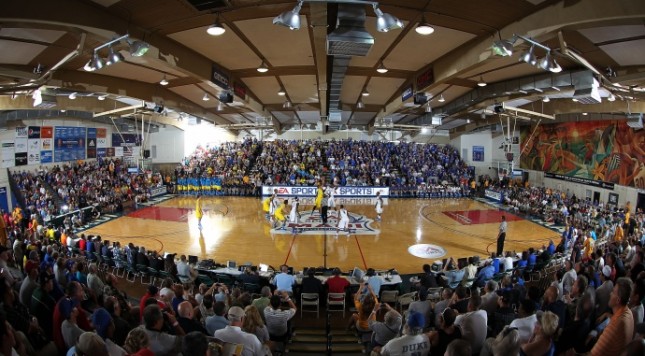The Maui Invitational has long been the most prestigious and famous tournament during the nonconference season. With moments like Chaminade’s upset over Ralph Sampson led Virginia, or Adam Morrison’s performance in the 2005 Maui Invitational, the tournament has grown into the invitation all schools hope to receive. The weather sure doesn’t hurt either, I bet.
The headliner is Arizona. The Wildcats are currently ranked 5th in the Pomeroy Ratings, and it’s not hard to see why. Rondae Hollis-Jefferson has made good on his preseason hype, shooting 71.4% on twos and contributing very well on the glass on both ends of the floor. But the big key for me has been the addition of Brandon Ashley. After missing the last half or so of the season last year, Ashley has been a key post presence for the Wildcats and has really opened up their offense, which went through periods of struggling without him.
Arizona will get Missouri in their first game. Missouri lost to Missouri-Kansas City in what was technically a part of the Maui Invitational (so do they have to give their spot up to the Kangaroos?), but have bounced back with two consecutive wins. First year coach Kim Anderson jettisoned some problem players off the team, and as a result the Tigers are very young. Junior Ryan Rosburg has one of the more interesting statlines of the early season, with a 62.5 percent eFG but just a 47.5 percent true shooting percentage thanks to making just three of 12 free throw attempts. The Tigers won’t be able to hang with Arizona, but could set up a matchup with a former Big 12 rival in the loser’s bracket.

Willie the Wildcat is in the Maui spirit
Kansas State comes into Maui fresh off a loss at Long Beach State. The Wildcats’ defense was the problem in their first two games, but against Long Beach State they scored only 60 points in 68 possessions. They’ve been scoring mostly by securing offensive rebounds and getting to the line, as has been their M.O. in recent years. Defensively, they’ve forced opponents to turn it over at an impressive clip, but they are struggling pretty much everywhere else. Most notably, they are allowing opponents to rebound 37.1 percent of their misses, which is roughly what Kansas State’s offensive rebounding rate is as well. They’re also allowing opponents to make 46.4 percent of their twos.
That will come into play with Purdue, who is led by potential Big Ten player of the year candidate AJ Hammonds. Hammonds has struggled offensively this year, shooting just 50 percent inside the arc and struggling from the free throw line, but his block percentage of 18.7 is 7th nationally and a big part of Purdue’s impressive defense thus far this season. The Boilermakers currently rank 4th in eFG allowed, 8th in turnovers forced, and 12th in block percentage. However, this will be Purdue’s first opponent ranked higher than 300 in KenPom, so expect to see those numbers take a bit of a dive after this week.
The bottom half of the bracket sees tournament hosts Chaminade taking on Pitt. Pitt will actually get four games in the state of Hawaii, as they took on the University of Hawaii on Friday, losing 74-70. (perhaps now we’re seeing why Jamie Dixon doesn’t want to schedule tough in the nonconference). Pitt is going to have to adjust without Lamar Patterson, who did virtually everything for the Panthers last season. The Panthers have been great offensively under Jamie Dixon, and they are playing well on offense yet again this year, making a high percentage of their twos, rarely turning it over, and hitting the offensive glass. Defensively has been a bit of a different story. Pitt allowed Hawaii to shoot 64.5 percent from two, and while they might be able to get away with that against Chaminade, they won’t be able to against their next opponent.
San Diego State might be the most intriguing team in the tournament. Most people are expecting to see the Aztecs take on Arizona in the title game, in a rematch of their Sweet 16 matchup last year, an exciting matchup that saw Arizona rally from 8 down with 16:41 left in the game to win by six. San Diego State has the distinction of playing in probably the most boring game of the season thus far, beating Utah 53-49 in 60 possessions. The Aztecs are looking for someone to replace All American Xavier Thames, but their defense is going to be good enough to wait for that player to come along. After ranking 9th defensively in KenPom last year, they are fourth this year. San Diego State opponents are shooting 38.1 percent on twos and a paltry 17.6 percent from beyond the arc. Obviously that number will come up a bit, but San Diego State’s ability to keep opponents from getting any good looks, and their ability to turn them over, will let them win a lot of games without the ability to score a point per trip.
Last but not least we have BYU. The Cougars are led by shooter Tyler Haws, who is shooting 38.4 percent from three for his career. Though he’s struggling a bit behind the arc so far this year, he’s been impressive inside the arc. BYU hasn’t been a threes heavy team under coach Dave Rose, but they’ll likely need to shoot quite a few of them against the Aztecs to pull off what would be a fairly shocking upset, even though they’re currently shooting just under 60 percent inside the arc. BYU point guard Skyler Halford currently has an assist rate of nearly 40 percent and is shooting 71 percent inside the arc, so needless to say he is a big key for the Cougars in this one:
Prediction: I am going to predict the final that everyone wants to see, and I am going to take the Aztecs to knock off Arizona in the title game.

